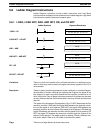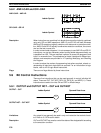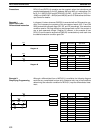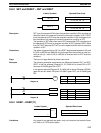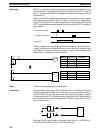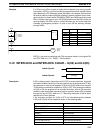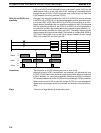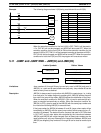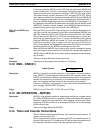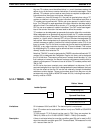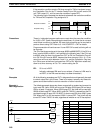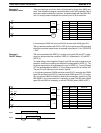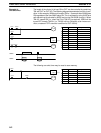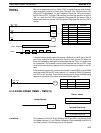
136
IL(02) and ILC(03) do not necessarily have to be used in pairs. IL(02) can be
used several times in a row, with each IL(02) creating an interlocked section
through the next ILC(03). ILC(03) cannot be used unless there is at least one
IL(02) between it and any previous ILC(03).
Changes in the execution condition for a DIFU(13) or DIFD(14) are not recorded
if the DIFU(13) or DIFD(14) is in an interlocked section and the execution condi-
tion for the IL(02) is OFF. When DIFU(13) or DIFD(14) is execution in an inter-
locked section immediately after the execution condition for the IL(02) has gone
ON, the execution condition for the DIFU(13) or DIFD(14) will be compared to
the execution condition that existed before the interlock became effective (i.e.,
before the interlock condition for IL(02) went OFF). The ladder diagram and bit
status changes for this are shown below. The interlock is in effect while 00000 is
OFF. Notice that 01000 is not turned ON at the point labeled A even though
00001 has turned OFF and then back ON.
00000
IL(02)
DIFU(13) 01000
ILC(03)
00001
00000
00001
ON
OFF
ON
OFF
01000
ON
OFF
A
Address Instruction Operands
00000 LD 00000
00001 IL(02)
00002 LD 00001
00003 DIFU(13) 01000
00004 ILC(03)
Precautions There must be an ILC(03) following any one or more IL(02).
Although as many IL(02) instructions as are necessary can be used with one
ILC(03), ILC(03) instructions cannot be used consecutively without at least one
IL(02) in between, i.e., nesting is not possible. Whenever a ILC(03) is executed,
all interlocks between the active ILC(03) and the preceding ILC(03) are cleared.
When more than one IL(02) is used with a single ILC(03), an error message will
appear when the program check is performed, but execution will proceed nor-
mally.
Flags There are no flags affected by these instructions.
DIFU(13) and DIFD(14) in
Interlocks
INTERLOCK and INTERLOCK CLEAR – IL(02) and ILC(03) Section 5-10




